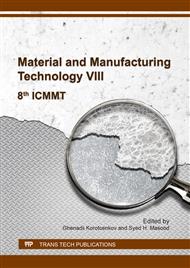[1]
Douglas C. Montgomery, Introduction to statistical quality control, 6th edition, John Wiley & Sons, USA, (2009).
Google Scholar
[2]
Jan Pana Rabatho, William Tongamp, Atsushi Shibayama, Yasushi Takasaki, Sachihito Nitta, Tetsuo Imai, Investigation of a Flotation Process with De-Sliming and Attrition to Upgrade and Recover Cu and Mo from a Cu-Mo Flotation Tailing, Materials Transactions, The Mining and Materials Processing Institute of Japan, 52 (4) (2011).
DOI: 10.2320/matertrans.m-m2011803
Google Scholar
[3]
E.A. Ponomarev, M. Neumann-Spallart, G. Hodes, C. Levy-Clement, Electrochemical deposition of MoS2 thin films by reduction of tetrathiomolybdate, Thin Solid Films, 280 (1996) 86-89.
DOI: 10.1016/0040-6090(95)08204-2
Google Scholar
[4]
Joel Voyer, Basil R. Marple, Tribological performance of thermally sprayed cermet coatings containing solid lubricants, Surface & Coatings Technology, 127 (2000) 155-166.
DOI: 10.1016/s0257-8972(00)00667-8
Google Scholar
[5]
C. Donnet, A. Erdemir, Solid lubricant coatings: recent developments and future trends, Tribology Letters, 17 (3) (2004) 389-397.
DOI: 10.1023/b:tril.0000044487.32514.1d
Google Scholar
[6]
You-Rong Liu, Jia-Jun Liu, Zhi Du, The cutting performance and wear mechanism of ceramic cutting tools with MoS2 coating deposited by magnetron sputtering, Wear, 231 (1999) 285-292.
DOI: 10.1016/s0043-1648(99)00168-4
Google Scholar
[7]
A. Jaworek, Electrospray droplet sources for thin film deposition, J Mater Sci, 42 (2007) 266-297.
DOI: 10.1007/s10853-006-0842-9
Google Scholar
[8]
Paturi UMR and Narala SKR. Experimental investigation to study the effect of electrostatic micro-solid lubricant–coated carbide tools on machinability parameters in turning. Proc IMechE, Part B: J Engineering Manufacture 2015; 229(5): 693–702.
DOI: 10.1177/0954405414530903
Google Scholar
[9]
Adrian G. Bailey, The science and technology of electrostatic powder spraying, transport and coating, Journal of Electrostatics, 45 (1998), 85-120.
DOI: 10.1016/s0304-3886(98)00049-7
Google Scholar
[10]
M. Barletta, A. Gisario, V. Tagliaferri, Electrostatic spray deposition (ESD) of polymeric powders on thermoplastic (PA66) substrate, Surface and Coatings Technology, 201 (2006), 296-308.
DOI: 10.1016/j.surfcoat.2005.11.120
Google Scholar
[11]
Paturi UMR and Narala SKR. Ona novel solid lubricant technique: A study on the tribological characteristics under dry slide condition Proc IMechE, Part J: J Engineering Tribology 2015; 229(12): 1503-1512.
DOI: 10.1177/1350650115587035
Google Scholar


